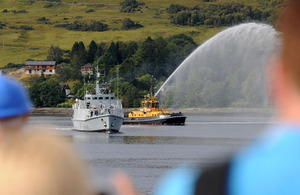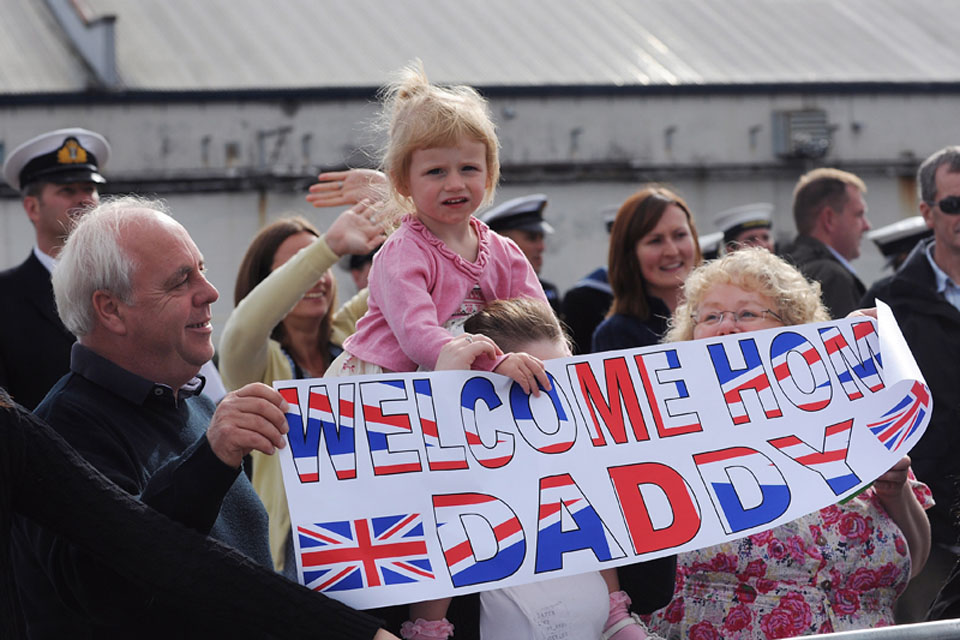HMS Grimsby home from the Gulf
Royal Navy minehunter HMS Grimsby returned to her home port of Her Majesty's Naval Base Clyde on Friday, 19 August 2011, after almost three years in the Gulf

HMS Grimsby returns to her home port of HM Naval Base Clyde [Picture: POA(Phot) Ian Arthur, Crown Copyright/MOD 2011]
There to greet the sophisticated Sandown Class mine countermeasures vessel were around 150 family members, friends and well-wishers, welcoming the First Mine Countermeasures Squadron (MCM1) crew home to Scottish shores.
Sailing HMS Grimsby was MCM1 Squadron Crew 5, the 34 men and women tasked with operating the ship for the past eight-and-a-half months in some of the most challenging conditions imaginable.
Commander David Bence, Commander MCM1, said:
It is great to see so many families on the jetty welcoming Grimsby home. It has been an impressive performance from an excellent crew who have been away for almost nine months. We should not underestimate the contribution they have made to the security and interests of the UK in the Gulf.
It is time now for the crew to enjoy a few quality weeks with their families. It is thoroughly deserved and great to see them home.
The Royal Navy rotates the crews of minehunters, with the ships staying in the region for years at a time and the different crews flying out to deploy onboard for several months. The system not only offers best value for money, but allows the sailors to get the maximum from their warm water training.
Crew 5 left the UK in December last year, leaving the snows blanketing the UK at the time for the warm climes of Bahrain to join HMS Grimsby.
The sailors were soon involved in a demanding programme which included stop-offs at Umm Qasr in Iraq to share knowledge of diving and damage control, taking part in a major exercise in the Gulf of Oman and carrying out live firings of close-range weapons, where Grimsby proved herself by destroying her target first time.

Families and friends wait to welcome home their loved ones as HMS Grimsby returns to her home port of HM Naval Base Clyde [Picture: POA(Phot) Ian Arthur, Crown Copyright/MOD 2011]
The deployment helped build lasting relationships in the region and gave the minehunter the chance to work alongside international partners such as the US Navy’s Avenger Class minehunter, USS Gladiator, which was also working in the area.
The crew received the news that they would leave Bahrain for the last time on 27 June 2011 and by the afternoon of the following day the ship was sailing east for the Strait of Hormuz for a seven-week, 7,000-nautical-mile (13,000km) journey home.
The transit back to Scotland encompassed stops at eight different countries to collect fuel and provisions and took the ship to the Republic of Djibouti on the Horn of Africa where they were ever vigilant for the activities of pirates in the region.
On the morning of 18 July 2011, HMS Grimsby set a course north west for home and entered the Red Sea. The ship next stopped off at the Royal Jordanian Naval Base to host dignitaries and senior UK and Jordanian military officials. Many of the crew also took the opportunity to enjoy a trip to Petra.
Accompanied by Royal Navy Hunt Class minehunter HMS Chiddingfold, Grimsby sailed through the Suez Canal on 28 July 2011 and entered the Mediterranean, passing destroyer HMS Liverpool en route.
Crossing the Bay of Biscay in conditions that could not have been more suitable, the ship made land at the Scilly Isles on 16 August 2011 - ahead of schedule and ready for the final leg of the journey that would see her slip safely home to HM Naval Base Clyde, back into the arms of loved ones.